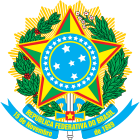
Back President van Brasilië Afrikaans President de Brasil AN رئيس البرازيل Arabic رئيس برازيل ARZ Прэзідэнт Бразіліі Byelorussian Президент на Бразилия Bulgarian Prezidanted Brazil Breton President del Brasil Catalan Presidente de Brasil CBK-ZAM سەرۆکی بەڕازیل CKB
| President of the Federative Republic of Brazil | |
|---|---|
| Presidente da República Federativa do Brasil | |
 | |
 | |
since 1 January 2023 | |
| Federal government of Brazil | |
| Style |
|
| Status | Head of state Head of government Commander-in-chief |
| Member of | Cabinet National Defense Council Council of the Republic |
| Residence | Palácio da Alvorada Granja do Torto |
| Seat | Palácio do Planalto |
| Appointer | Direct popular vote (two rounds if necessary) |
| Term length | Four years, renewable once consecutively |
| Constituting instrument | Constitution of Brazil |
| Precursor | Emperor of Brazil (as Head of State) Prime Minister of Brazil (as Head of Government) |
| Inaugural holder | Deodoro da Fonseca |
| Formation | Proclamation of the Republic 15 November 1889 |
| Succession | Line of succession |
| Deputy | Vice President |
| Salary | R$ 402,151/US$ 76,309 annually[2] |
| Website | www |
| This article is part of a series on the |
 |
|---|
The president of Brazil (Portuguese: presidente do Brasil), officially the president of the Federative Republic of Brazil (Portuguese: presidente da República Federativa do Brasil) or simply the President of the Republic, is the head of state and head of government of Brazil. The president leads the executive branch of the federal government and is the commander-in-chief of the Brazilian Armed Forces.
The presidential system was established in 1889, upon the proclamation of the republic in a military coup d'état against Emperor Pedro II. Since then, Brazil has had six constitutions, three dictatorships, and three democratic periods. The Constitution of Brazil, along with several constitutional amendments, establishes the requirements, powers, and responsibilities of the president, their term of office and the method of election.[3]
Luiz Inácio Lula da Silva is the 39th and current president. He was sworn in on 1 January 2023.
- ^ "Decreto nº 9.758, de 11 de abril de 2019". Diário Oficial da União (in Portuguese). No. 70–A. Impressa Nacional. 11 April 2019. p. 5. ISSN 1677-7042. Retrieved 4 February 2021.
- ^ [1], Ministry of Transparency, Supervision and Control. Retrieved on 15 May 2021. (in Portuguese)
- ^ Constitution of the Federative Republic of Brazil, art. 15 and Chapter II
